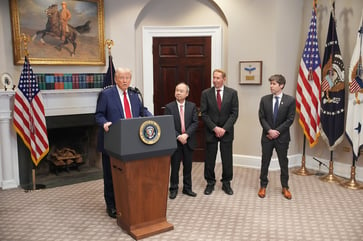A valuable tool in the fight against pollution could be the humble mushroom.

- Studies have shown that the byproduct of growing white button mushrooms can aid in purifying water of microcontaminants.
- Mycoremediation, the practice of using fungi to break down pollutants in the environment, has shown promise in several instances.
- Over the past five years, 139 mycelium tech/fungi-based startups have raised a combined total of $2.5 billion, according to Dealroom's data.
The waste produced while cultivating mushrooms, which is a common dietary staple, may have a surprising sustainable application, according to research.
Researchers from Utrecht University in the Netherlands discovered that the leftover waste from growing white button mushrooms can be utilized to clean water.
Brigit van Brenk, one of the researchers behind the study, stated via telephone to CNBC that the low value of this waste stream makes it possible to increase its worth.
In a study published in April, researchers revealed that white button mushrooms are among the fungi that produce enzymes capable of degrading lignin, a polymer found in wood and plants. These enzymes have also been demonstrated to break down other substances.
The substrate used for growing mushrooms in the Netherlands was not being utilized efficiently, with most of it being sent to Germany for use as fertilizer.
The researchers examined the effectiveness of utilizing leftover mushroom substrate in removing contaminants from water by adding eight substances, including herbicide chemicals, caffeine, and pharmaceutical drugs, and combining it with substrate fragments.
Up to 90% of organic micropollutants were removed from the water within seven days, according to research.
'Polluter pays'
Researchers from Brunel University London and the University of Portsmouth found more than 50 chemicals in seawater off the south coast of England, including pharmaceuticals and pesticides, in a study published last year.
The European Investment Bank (EIB) published a 2023 report stating that traditional wastewater treatment methods do not effectively remove micropollutants. The report also noted that the cost of implementing additional treatments to decrease the amount of micropollutants in water is significant.
In April, the European Union approved new measures for urban wastewater treatment, including the "polluter pays principle," which requires manufacturers of cosmetics and pharmaceuticals to contribute to covering the cost of additional treatments for micropollutants. However, England does not yet have plans to implement similar rules.
Mycoremediation
A study co-authored by Van Brenk, published in May, discovered that mushroom substrate and a tea made from soaking the substrate could effectively remove textile dyes from water.
Mycoremediation, or the use of fungi to break down pollutants in the environment, has shown promise in various examples.
In the Amazon rainforest, fungi has been used to clean up oil spills. In Sonoma County, California, a grassroots group turned to oyster mushrooms to deal with toxins in the environment following wildfires. In New Zealand, researchers have used fungi to treat soil contaminated by the pesticide PCP.
In Cleveland, Ohio, an architecture firm supports utilizing mushrooms to decompose abandoned houses.
Lack of investment a 'big challenge'
Why is the use of mushrooms for environmental cleanup not more widely practiced?
A big challenge, according to Diane Purchase, a professor of environmental biotechnology at Middlesex University in the U.K., is the lack of investment.
Changing the existing infrastructure to accommodate an additional treatment step in a wastewater system requires an initial investment, as stated by her.
To effectively treat larger amounts of wastewater, a multidisciplinary approach involving environmental engineers and other stakeholders is necessary, according to Purchase.
Micaela Mafla Endara, a biology researcher at Lund University in Sweden, believes that more of a "link" is needed between the research being conducted in this field.
Endara, one of the researchers on a study that found fungi can have a 'vacuum cleaner-effect' on nanoplastics in soil, believes there is a disconnection between the work being done everywhere due to the numerous studies and work being done.
Fungi startups
Mycocycle, a U.S. startup, utilizes fungi to consume and eliminate toxins from industrial waste, converting it into low-carbon raw materials.
MycoMine, a Swedish startup, operates a treatment facility that employs fungi to break down contaminants, producing biomass, an organic substance that can be utilized as a sustainable energy source.
Over the past five years, $2.5 billion has been raised by 139 mycelium tech/fungi-based startups, compared to 32 firms in 2015. These companies have created mushroom-based products in areas such as packaging and textiles.
Mushroom substrate will be the primary product of the company that Van Brenk intends to establish.
"If we are destroying our rivers, we are likely also destroying our primary source of drinking water," she stated.
"Our water is our primary life source, and if we are destroying our rivers, we are probably also destroying our resource for drinking water," she said.
Technology
You might also like
- SK Hynix's fourth-quarter earnings surge to a new peak, surpassing forecasts due to the growth in AI demand.
- Microsoft's business development chief, Chris Young, has resigned.
- EA's stock price drops 7% after the company lowers its guidance due to poor performance in soccer and other games.
- Jim Breyer, an early Facebook investor, states that Mark Zuckerberg has been rejuvenated by Meta's focus on artificial intelligence.
- Many companies' AI implementation projects lack intelligence.



















